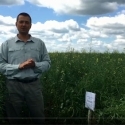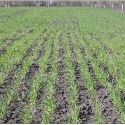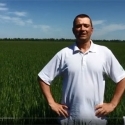31 Mar 2015
Results of research project on the improvement of K fertilizer recommendations in intensive cropping systems in Russia in 2014
Svetlana Ivanova, Vladimir Romanenkov and Lubov Nikitina
A year before, this journal published the first results of the joint project of the International Plant Nutrition Institute and the Pryanishnikov Research Institute of Agrochemistry launched in the fall of 2012. The project is focused on optimization of potash fertilizer rates in current intensive cropping systems for crops with high demand to K (sugar beet, grain maize, rapeseed and soybean), as well as checking the measurement potential of routine soil test methods depending on the regional soil properties and adjusting the current soil K test interpretation classes based on the results obtained from short-term field experiments executed on large industrial farms (Ivanova et al., 2014). The results obtained in the fall of 2014, the second year of study, are presented in this paper.
To continue the study of the response of sugar beet, rapeseed, soybean, and grain maize to potassium fertilizers, the second series of short-term field experiments was established in the Central Chernozemic (Lipetskii and Voronezhskii centers of agrochemical service, Belgorod National Research University) and North-Caucasian (Rostovskii Center of Agrochemical Service) regions. The experiments were established in the large industrial farms, where the yield of crops was higher than the average regional level, on chernozems with the medium to high contents of plant-available potassium. These experiments will last for two years in crop rotation. The effect of four increasing K rates on the background of optimal NP supply against the absolute control (without fertilizers) is being studied in the experiments. Potassium fertilizers were applied in the form of granulated potassium chloride for the crop with the highest demand in K in rotation.
In the fall of 2014, the effect of potassium fertilizers on the yields of the target and by-products was assessed in the experiments with the following crops: sugar beet and grain maize in Voronezh oblast; sugar beet and spring rapeseed in Lipetsk oblast, soybean in Belgorod oblast; and sugar beet and grain maize in Rostov oblast.
Each experimental treatment is performed in triplicate, with the study of the residual effect of the single application rate of potassium fertilizers on the next crops in the crop rotation.
The following treatments were used in the experiments with sugar beet: without fertilizers (absolute control); NP at the optimal rates for the farm (background); background + K70 (K1); background + K140 (K2); background + K210 (K3); and background + K280 (K4).
In the experiments with the second crop, the following treatments were used: for grain maize: without fertilizers (absolute control); NP at the optimal rates for the farm (background); background + K60 (K1); background + K120 (K2); background + K180 (K3); and background + K240 (K4); for soybean and spring rapeseed: without fertilizers (absolute control); NP at the optimal rates for the farm (background); background + K30 (K1); background + K60 (K2); background + K90 (K3); and background + K120 (K4).
In addition, the residual effect of potassium fertilizers applied in the fall of 2012 for the previous crop in the experiments of the first stage (fall 2012–2013), the results of which were reported earlier (Ivanova et al., 2014),was also studied.
In 2014 due to comparatively more arid conditions of the vegetation period the yield levels for all studied crops were much lower than in 2013. Let us consider the results obtained in each region in more details.
Voronezh oblast
In the experiment performed in Voronezh oblast, a high yield (more than 50 t/ha) was obtained for sugar beet (hybrid Rosanta). It was found that potassium fertilizers had a positive effect, which increased the yield of sugar beet roots by 15–21% at the application of double (140 kg K2O/ha), triple (210 kg K2O/ha), and maximum (280 kg K2O/ha) potassium rates compared to the nitrogen–phosphorus background. The sugar content in the beet roots did not decrease due to the positive effect of potassium fertilizers, which ensured the corresponding increase in the yield of sugar from 6.7 to 8.0 t/ha (Fig. 1).
Tabl. 1. Effect of potash fertilizers on yield increase in 2014.
Direct effect of K applications, the second series of on-field trails
Region | Crop | Maximum yield increase due to K, % |
| Voronezh | Sugar beet | 24* |
| Grain maize | 15 | |
| Lipetsk | Sugar beet | 12 |
| Spring rapeseed | 14 | |
| Belgorod | Soybean | 7 |
| Rоstov | Sugar beet | 10 |
| Grain maize | 8 |
Residual effect of K fertilizer (1 year after K application), first series of on-field trials
Region | Crop | Maximum yield increase due to K, % |
| Voronezh | Spring barley | 18 |
| Spring wheat | 20 | |
| Lipetsk | Winter wheat | 16 |
| Winter wheat | 33 | |
| Belgorod | Winter wheat | 4 |
| Spring barley | 7 | |
| Rоstov | Winter wheat | 10 |
| Winter wheat | 4 |
Figure 1.Effect of Kfertilizer application on sucrose yield in the field experiments conducted in 2014. Blue line – Voronezhskaya oblast, red line – Lipetskaya oblast
In the experiment with grain maize, the application of potassium fertilizers significantly increased the yield of grain by 5–15% without losing its quality. The maximum yield (3.6 t/ha) was reached in the treatment with the application of potassium at a rate of 120 kg K2O/ha. The maximum yield increase due to K was 0.5 t/ha. Thus, every applied kilogram of K2O resulted in additional 4 kg of maize grain.
In the experiment on the study of the residual effect of potassium fertilizer on spring wheat, a reliable increase in crop yield by 9–20% compared to the nitrogen–phosphorus background was obtained in the treatments with the double (140 kg K2O/ha), triple (210 kg K2O/ha), and maximum (280 kg K2O/ha) potassium rates applied for the previous crop: sugar beet. The maximum yield of spring wheat (4.1 t/ha) was reached in the treatment with the application of the maximum potassium rate (280 kg K2O/ha), and the grain quality corresponded to class I of soft spring (here and below, according to Russian standard GOST R 52554-2006), because the content of gluten was 32% and the gluten deformation index (IDK) decreased to 75 units; in the other treatments, class II grain was obtained. The maximum yield increase due to the application of potassium was 0.7 t/ha. Thus, every applied kilogram of K2O resulted in additional 2.5 kg of spring wheat grain. In the experiment on the study of the residual effect of potassium fertilizer on spring barely, a reliable increase in crop yield by 12–18% compared to the nitrogen–phosphorus background was obtained in the treatments with the triple (180 kg K2O/ha) and maximum (240 kg K2O/ha) potassium rates applied in the fall of 2012 for the previous crop: grain maize. The maximum yield increase due to the application of potassium was 0.8 t/ha. Thus, every applied kilogram of K2O resulted in additional 3.3 kg of spring wheat grain. The aftereffect of potassium increased the weight of 1000 grains (by 5%) and the content of protein in the grain. The latter fact can by critical for the cultivation of malting barley varieties.
Lipetsk oblast
In the experiment with sugar beet (hybrid Ventura) performed in Lipetsk oblast, a medium yield (up to 36 t/ha) was reached, and a positive effect of potassium fertilizers was noted at the application of all rates with a reliable increase in the yield of roots by 7–14% compared to the nitrogen–phosphorus background. The yield of sugar increased by up to 26% (from 6.5 to 8.2 t/ha), which was due to both the increase of the crop yield and the sugar content in beet roots by 3% on the average compared to the NP background.
In the experiment with spring rape (cultivar Ratnik), a maximum yield of 1.25 t/ha was obtained. The potassium fertilizers ensured a reliable increase of rape yield by 6–28% compared to the nitrogen–phosphorus background. The increase of yield was accompanied by the retention of oil content in seeds and the almost double decrease in their acid number, which improved rapeseeds storage. The maximum yield increase due to potassium fertilizers was 0.15 t/ha. Thus, every applied kilogram of K2O resulted in additional 2.5 kg of rapeseeds. In two experiments on residual effect of potassium fertilizer applied for the previous crop in rotation (sugar beet and rape) on winter wheat, a reliable increase in yield compared to the nitrogen–phosphorus background was observed in all experimental treatments. The yield increase due to the application of potassium fertilizer was 8–33%. The aftereffect of potassium increased the content of protein in wheat grain by 1–1.7%, the grain unit by 5–10 g, and grain hardness. The improvement of grain quality for the Bezenchukskaya-380 winter wheat cultivar allowed obtaining class I grain in the treatments with the residual effect of the single (60 kg K2O/ha), double (120 kg K2O/ha), and maximum (240 kg K2O/ha) rates of potassium fertilizer applied for the previous crop (rape) in the fall of 2012. The maximum yield increase due to potassium fertilizer was 0.7 t/ha. Thus, every applied kilogram of K2O resulted in additional 4 kg of wheat grain. The improvement of grain quality for the Moskovskaya-39 winter wheat cultivar allowed obtaining class I grain in the treatments with the aftereffect of the single (70 kg K2O/ha), triple (210 kg K2O/ha), and maximum (280 kg K2O/ha) rates of potassium fertilizer applied for the preceding crop (sugar beet) in the fall of 2012. The maximum gain in yield due to potassium fertilizer was 0.8 t/ha. Thus, every applied kilogram of K2O resulted in additional 4.5 kg of wheat grain per In both experiments, grain of the lower class II was obtained in the treatment with the application of only nitrogen and phosphorus fertilizers.
Belgorod oblast
In the experiment with soybean (cultivar Lantsetnaya), a significant increase in yield by 6–7% compared to the nitrogen–phosphorus background was reached in the treatments with the application of 60–120 kg K2O/ha. The maximum gain in yield due to potassium fertilizer was 0.12 t/ha. Thus, every applied kilogram of K2O resulted in additional 1.3 kg of soybeans. The increase in the yield of soybeans occurred at their stable quality: the contents of protein and oil remained at levels of 36 and 20%, respectively.
In the experiment studied residual effect of potassium fertilizers, a reliable increase in the yield of malting barley by 5–7% compared to the NP background was obtained in the treatments with the application of 60–240 kg K2O/ha for the previous crop in rotation (grain maize) in the fall of 2012. The maximum yield increase due to potassium fertilizer was 0.3 t/ha. Thus, every applied kilogram of K2O resulted in additional 1.6 kg of spring barley grain.
When the yield increased, the content of protein in grain remained stable at a level of 9.5–9.8%.
Rostov oblast
In Rostov oblast, the effect of potassium fertilizers on the yield of sugar beet was insignificant because of the high spatial variation of the data. However, an increase in the content of sugar by 1% was observed in the treatments with the application of potassium fertilizers, and the yield of sugar increased by 7–9% (up to 8.7–8.9 t/ha). In the experiment with grain maize, the reliable increase in yield was 0.5 t/ha, or 8%, in the treatment with the application of 180 kg K2O/ha. Thus, every applied kilogram of K2O resulted in additional 3.0 kg of maize grain. In 2014 the comparison of the economic efficiency of potassium fertilizers applied for different crops with consideration for the cost of granulated potassium chloride—13 000 rubles/t, including the price of the fertilizer (11 000 rubles/t) and its delivery to the field (2000 rubles/t), shows that the most efficient was the application for sugar beet with the maximum increase in revenue by 15 thousand rubles/ha in Voronezh oblast and by 5 thousand rubles/ha in Lipetsk oblast. The maximum increase in profitability for sugar beet was 6% in Lipetsk oblast and 21% in Voronezh oblast.
At the cultivation of rape in Lipetsk oblast, the maximum increase in revenue was 380 rubles/ha at a fertilizer rate of 60 kg K2O/ha, and the profitability increased by 1%.
In the experiments on residual effect of potassium application on cereals, a sustainable increase in profitability was obtained at the application of potassium fertilizers. The maximum increase in revenue compared to the NP background (4200–6075 rubles/ha), as well as the maximum increase in profitability, was obtained for winter wheat in Lipetsk oblast. For spring crops (barley and wheat), the maximum increase in revenue was 3000–3800 rubles/ha at the application of the triple and maximum potassium rates; the profitability increased by 33–54% compared to the background.
The results of this 3-yaers project will be summarized and published in the next year; however, from the results of the first two years, a practical conclusion can be drawn that the nonapplication of potassium fertilizers to chernozems with medium to high content of plant available K results in a significant loses in the productivity of sugar beet, maize grain, rapeseeds, and soybeans. The application of potassium fertilizers not only increases the yield and improves the quality of these crops in the first year of application, but also has a significant positive residual effect on the yield and quality of cereals - the next crop in rotation (such as spring and winter wheat, barley).
References:
S. Ivanova, V. Romanenkov, L. Nikitina. First results of research project on the improvement of K fertilizer recommendations in intensive cropping systems in Russia. Key Element, #1 2014, pp. 6-10.




